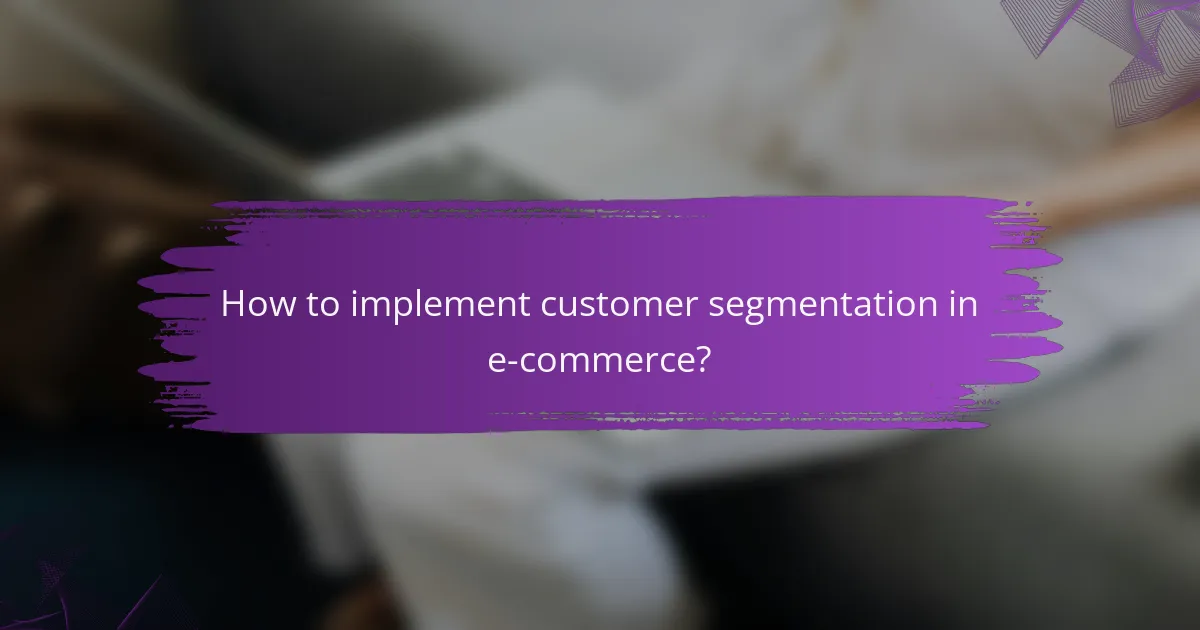E-commerce personalization is a powerful strategy that enhances customer experiences by customizing interactions based on individual preferences and behaviors. By leveraging essential data such as purchase history, demographic information, and browsing patterns, businesses can create more relevant product offerings and improve engagement. Additionally, effective customer segmentation allows for targeted marketing strategies, ultimately leading to increased customer satisfaction and sales.

How can e-commerce personalization enhance customer experience?
E-commerce personalization enhances customer experience by tailoring interactions based on individual preferences and behaviors. This approach leads to more relevant product offerings, improved engagement, and ultimately higher customer satisfaction.
Improved product recommendations
Personalized product recommendations leverage customer data to suggest items that align with individual tastes. By analyzing past purchases, browsing history, and similar customer profiles, e-commerce platforms can present products that are more likely to resonate with each shopper.
For example, if a customer frequently buys outdoor gear, the system might recommend hiking boots or camping equipment. This targeted approach can increase conversion rates significantly, as customers feel understood and catered to.
Tailored marketing messages
Tailored marketing messages are crafted based on customer segmentation, ensuring that promotions and communications are relevant. By utilizing data such as demographics, purchase history, and engagement levels, businesses can create messages that speak directly to the needs and interests of specific groups.
For instance, a brand might send a special offer on winter apparel to customers who have previously purchased seasonal clothing. This increases the likelihood of engagement and conversion, as the offers feel more personalized and timely.
Dynamic website content
Dynamic website content adjusts in real-time based on user behavior and preferences, creating a unique browsing experience for each visitor. This can include personalized landing pages, product displays, and even tailored navigation paths that guide users toward items they are likely to purchase.
For example, a returning customer might see a homepage featuring products they viewed previously, while new visitors are shown popular items or bestsellers. This customization helps keep users engaged and encourages them to explore further.
Personalized email campaigns
Personalized email campaigns utilize customer data to deliver relevant content directly to inboxes. By segmenting email lists based on customer behavior and preferences, businesses can send targeted promotions, product recommendations, and personalized messages that resonate with each recipient.
For example, a customer who recently purchased a camera might receive an email featuring accessories or photography tips. This approach not only increases open and click-through rates but also fosters a stronger connection between the brand and the customer.

What data is essential for e-commerce personalization?
Essential data for e-commerce personalization includes customer behavior analytics, purchase history data, demographic information, and browsing patterns. Utilizing these data points allows businesses to tailor their offerings and enhance the shopping experience for individual customers.
Customer behavior analytics
Customer behavior analytics involves tracking and analyzing how users interact with an e-commerce platform. This data can reveal preferences, engagement levels, and potential pain points, enabling businesses to optimize their website and marketing strategies accordingly.
Key metrics to monitor include click-through rates, time spent on site, and conversion rates. By understanding these behaviors, companies can create targeted campaigns that resonate with specific customer segments.
Purchase history data
Purchase history data provides insights into what products customers have bought in the past, allowing businesses to predict future buying behavior. This information can be used to recommend similar or complementary products, enhancing the likelihood of repeat purchases.
For example, if a customer frequently buys outdoor gear, personalized recommendations for related items like camping accessories can be effective. Regularly updating this data helps maintain relevance in recommendations.
Demographic information
Demographic information includes data such as age, gender, location, and income level. This data helps businesses understand their target audience and tailor marketing messages to align with specific customer needs and preferences.
For instance, a brand selling luxury goods may focus its efforts on higher-income demographics, while a budget-friendly retailer might target a broader audience. Segmenting customers based on demographics allows for more effective and personalized marketing strategies.
Browsing patterns
Browsing patterns track how customers navigate an e-commerce site, including which pages they visit and how long they stay. This data can highlight popular products and identify areas where customers may lose interest or abandon their carts.
By analyzing browsing patterns, businesses can optimize site layout and product placements. For example, if many users drop off at the checkout page, simplifying the process or offering incentives like free shipping may improve conversion rates.

How to implement customer segmentation in e-commerce?
Implementing customer segmentation in e-commerce involves categorizing customers based on shared characteristics to tailor marketing strategies effectively. This approach enhances customer experience and boosts sales by delivering personalized content and offers.
Behavioral segmentation
Behavioral segmentation focuses on customer interactions with your brand, including purchase history, browsing patterns, and engagement levels. By analyzing these behaviors, you can identify distinct groups, such as frequent buyers or seasonal shoppers.
For example, you might target frequent buyers with loyalty rewards, while occasional shoppers could receive personalized recommendations based on their previous purchases. This targeted approach can significantly improve conversion rates.
Demographic segmentation
Demographic segmentation divides customers based on quantifiable characteristics such as age, gender, income, and education level. This information helps in crafting messages that resonate with specific groups.
For instance, a luxury brand might focus on high-income individuals aged 30-50, while a budget-friendly retailer could target younger consumers with lower disposable income. Tailoring your marketing efforts to these demographics can enhance relevance and engagement.
Geographic segmentation
Geographic segmentation categorizes customers based on their location, which can influence buying behavior and preferences. Understanding regional trends allows businesses to customize their offerings and marketing strategies accordingly.
For example, a clothing retailer might promote winter apparel in colder regions while focusing on summer wear in warmer areas. Additionally, local regulations and cultural preferences should be considered when developing marketing campaigns.
Psychographic segmentation
Psychographic segmentation delves into customers’ lifestyles, values, interests, and personalities. This method provides deeper insights into what drives customer decisions beyond basic demographics.
For instance, a brand targeting environmentally conscious consumers might emphasize sustainability in its messaging. Understanding these psychographic factors can lead to more meaningful connections and foster brand loyalty.

What tools can optimize e-commerce personalization?
Several tools can significantly enhance e-commerce personalization by leveraging customer data, enabling targeted marketing, and improving user experiences. These tools help businesses analyze customer behavior, segment audiences, and tailor content to individual preferences.
Shopify Plus
Shopify Plus is a robust e-commerce platform designed for high-volume merchants. It offers advanced features like customizable checkout experiences and automated workflows that enhance personalization. Businesses can utilize Shopify’s extensive app ecosystem to integrate tools that analyze customer data and optimize marketing strategies.
For example, merchants can use Shopify Plus to create personalized product recommendations based on browsing history. This can lead to increased conversion rates and improved customer satisfaction.
Adobe Experience Cloud
Adobe Experience Cloud provides a comprehensive suite of tools for managing customer experiences across various channels. It combines analytics, content management, and marketing automation to deliver personalized experiences. Users can segment audiences based on behavior, demographics, and preferences, allowing for targeted campaigns.
With Adobe’s AI-driven insights, businesses can predict customer needs and tailor their offerings accordingly. This proactive approach can significantly enhance customer engagement and loyalty.
Segment
Segment is a customer data platform that helps businesses collect, unify, and activate customer data across different channels. It allows for detailed customer segmentation, enabling personalized marketing efforts based on real-time data. By integrating with various marketing tools, Segment ensures that businesses can deliver consistent and relevant experiences.
For instance, companies can use Segment to track user interactions and create targeted email campaigns that resonate with specific segments, improving open and conversion rates.
Dynamic Yield
Dynamic Yield is a personalization platform that enables businesses to deliver tailored experiences across web, mobile apps, and email. It uses machine learning to analyze user behavior and preferences, allowing for real-time personalization. Companies can create dynamic content, product recommendations, and targeted offers based on individual user data.
By implementing Dynamic Yield, e-commerce businesses can enhance user engagement and drive sales through personalized shopping experiences that adapt to customer needs and preferences.


